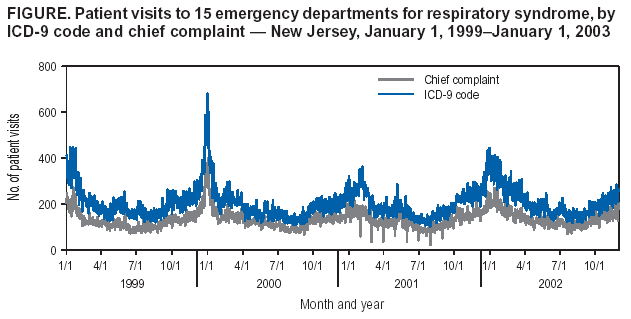 |
|
|
|
|
|
|
| ||||||||||
|
|
|
|
|
|
|
||||
| ||||||||||
|
|
|
|
|
Persons using assistive technology might not be able to fully access information in this file. For assistance, please send e-mail to: mmwrq@cdc.gov. Type 508 Accommodation and the title of the report in the subject line of e-mail. Biosurveillance of Respiratory Disease in the Emergency Department --- Chief Complaint and ICD-9 CodeMelissa Mocny,1 D.
Cochrane,2,4 J. Allegra,2,4 T. Nguyen,1 J. Pavlin,3 J. Rothman,4 R. Heffernan,5
Corresponding author: Dennis G. Cochrane, Morristown Memorial Hospital Residence in Emergency Medicine, Morristown, NJ 07962. Telephone: 973-971-8919; E-mail: cochraned@verizon.net. AbstractIntroduction: International Classification of Diseases, Ninth Revision (ICD-9) codes and patient chief complaints have both been advocated for use in syndromic surveillance of emergency department (ED) visits. Objectives: The objective of this analysis was to determine whether two algorithms, one based on ICD-9 codes and the other on patient chief complaints, identified similar patterns and patient populations for respiratory illness. An attempt was also made to improve agreement by equalizing and expanding syndrome definitions. Methods: Retrospective analysis was performed for consecutive visits to 15 New Jersey EDs. The Electronic Surveillance System for the Early Notification of Community-Based Epidemics (ESSENCE) project supplied a then-current version of its ICD-9 algorithm. The New York State Department of Health extended a chief-complaint algorithm originally developed by the New York City Department of Health and Mental Hygiene and also made modifications to ESSENCE ICD-9 code groupings. A time-series graph was generated, and a correlation coefficient was calculated. Agreement between the two algorithms was examined in three stages: 1) initial chief complaint and ICD-9 algorithms, 2) after modifying the algorithms to match more closely, and 3) after expanding both algorithms to include fever. Results: A total of 2,250,922 visits were used to compare seasonal variations as measured by the two methods (Figure). High correlation existed between the two algorithms (r = 0.90; p<0.01). A subset of 174,520 visits was examined; for stages 1, 2, and 3, respectively, agreement by kappa statistic was 0.28 (fair), 0.42 (moderate), and 0.56 (moderate); sensitivity was 0.31, 0.53, and 0.71; and specificity was 0.94, 0.91, and 0.90. Conclusions: ICD-9 and chief-complaint algorithms for respiratory syndrome identified similar patterns of illness. The level of agreement was improved both by equalizing and by expanding the syndrome definitions. Figure Return to top.
Disclaimer All MMWR HTML versions of articles are electronic conversions from ASCII text into HTML. This conversion may have resulted in character translation or format errors in the HTML version. Users should not rely on this HTML document, but are referred to the electronic PDF version and/or the original MMWR paper copy for the official text, figures, and tables. An original paper copy of this issue can be obtained from the Superintendent of Documents, U.S. Government Printing Office (GPO), Washington, DC 20402-9371; telephone: (202) 512-1800. Contact GPO for current prices. **Questions or messages regarding errors in formatting should be addressed to mmwrq@cdc.gov.Page converted: 9/14/2004 |
|||||||||
This page last reviewed 9/14/2004
|